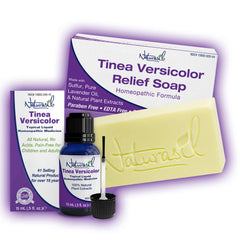Though the different forms of tinea are related, they each present a little differently, which can sometimes cause confusion in identifying the cause of the condition and, thus, allowing for efficient and proper treatment.
Tinea Corporis
Perhaps one of the most well-known forms of tinea is tinea corporis, also known as ringworm of the body. When on the body—usually the torso, arms, or legs—ringworm presents as a red, circular-shaped scaly rash that can often have a ‘normal’ colored center. On people with darker skin colors, the rash could also be purple, gray, or brown.
Cases of tinea corporis can present as just one ring or several; in addition, it can be uncomfortable and very itchy. The particular shape of the rash is where the name ‘ringworm’ comes from: it is shaped like a ring, but no worms are actually involved. This condition is actually caused by a highly contagious fungal infection.
Tinea Cruris
Just like tinea corporis, tinea cruris (a condition most commonly known as jock itch) presents as a patch of these red, circular-shaped patches forming a rash across the buttocks, inner thighs, or groin. The skin may again be reddened, itchy, scaly, and affected by patches of hair loss.
Tinea Capitis
Similarly, tinea capitis (or ringworm of the scalp) can be identified by the trademark red rash or itchy and scaly patches. Due to the changes in the skin caused by the dermatophytes that are at the root of the fungal infection, the most common symptom of tinea capitis is patchy hair loss, accompanied by redness, scaliness, and itching.
Tinea Versicolor
Tinea versicolor looks quite different from other types of tinea that affect the skin, and that is because this is caused by a different type of fungus. Instead of the dermatophytes that cause ringworm and jock itch, tinea versicolor is caused by the overgrowth of a kind of yeast that lives naturally on your body.
While scaliness of the skin and itching can sometimes also be symptoms of tinea versicolor, the main aesthetic difference is the form of rash that this condition presents. Tinea versicolor often looks like patches of skin discoloration; these patches may be red, pink, or pale brown on lighter skin. On darker skin tones, the discoloration may be paler than the surrounding skin.
Generally, tinea versicolor affects the torso, neck, upper back, and upper arms. It can cover large areas or present as small patches. Unlike the rest of the skin, patches of discoloration caused by tinea versicolor won’t tan in the sun.
Tinea Pedis
Also known as athlete’s foot, tinea pedis has several characteristic aesthetic symptoms, as well as itching and sometimes bleeding. Often presenting as flaky white, peeling patches between the toes, this fungal infection can also affect the soles of the feet. Sometimes, the skin will become red and blistered, and in rarer cases, tinea pedis can cause blisters on the feet—both between the toes and on the soles.
Tinea Unguium
Tinea unguium (also known as onychomycosis or toenail fungus) is another fungal infection, this time affecting the toenails. In rare cases, this can be the result of a severe case of tinea pedis. The dermatophytes that infect the toenail—often through damage to the nail—generally cause a change in nail color, including whitening, yellowing, or browning of the nail. In addition, those with toenail fungus may notice that the toenails become broken, thicker, or misshapen, and they may have a cloudy appearance. In rare cases, the toenail could crumble or become blackened.






